This article contains affiliate links. If you make a purchase after clicking on a link I may earn a small commission at no extra cost to you.
Seafood Allergy & Intolerance
Over the last few decades, there has been an increase in the consumption of seafood. Often this increase is due to the health benefits associated with the consumption of some seafood.
Seafood is rich source of omega-3 fatty acids, protein and other essential nutrients, it is not surprising that individuals are now shifting from lean meat to fish.
Unfortunately however, some individuals who make the change may find that they are allergic to seafood.
Given the rising numbers of fish eaters, the number who suffer from this allergy are also on the rise.
Fish allergies include allergies to fish and to shellfish.
Studies have shown that nearly 7 million Americans may be affected by this condition, with the allergy being more common in adults than in children. In this article, we shall briefly take a look at seafood allergy.
Types of seafood
 It must be remembered that seafood allergies are often not limited to just one type of seafood, but can be to all varieties. Seafood can include crustaceans, molluscs and cartilaginous fish.
It must be remembered that seafood allergies are often not limited to just one type of seafood, but can be to all varieties. Seafood can include crustaceans, molluscs and cartilaginous fish.
Of course, the opposite is also true, and people who are allergic to shellfish may not have the same allergies to bony fish.
Nevertheless, it is worthwhile being careful when trying any kind of fish if you have a seafood allergy.
Cause of the allergy
The primary allergen that is responsible for seafood allergy is muscle protein tropomyosin.
While this is present in crustaceans and molluscs, other allergens such as parvalbumin and the presence of certain parasite in fish meat can all trigger an allergic response.
Seafood Allergy Symptoms
Individuals who are allergic to seafood may develop nausea, vomiting, abdominal cramps and skin flushing, amongst a variety of other symptoms. Most reactions to seafood occur within 2 hours of consumption, though there are reports where a delayed response can occur after around 8 hours. On rare occasions, allergic reactions can be fatal.
Reports also suggest that some people can be allergic to the mere smell of fish or to the aromas and odors produced during cooking.
Diagnosis and treatment
Many a times, seafood allergy can be detected from clinical history and examination of the patient during an allergic reaction. Specialized tests such as skin prick tests can be done to look for the presence of specific antibodies.
The best way to manage seafood allergy is to avoid consumption completely. However, if accidental consumption does occur, it is wise to seek medical advice immediately. Allergies can progress rapidly progress, and timely medical treatment is lifesaving.
These days, foods available in supermarkets often have an allergy label on them that alert people whether the product may be contaminated with seafood. Allergy sufferers must look out for these.
Conclusion
Seafood allergy is a common problem, and can be best treated by prevention. Hospitalisation may be required on some occasions, and untreated cases can be life threatening.
